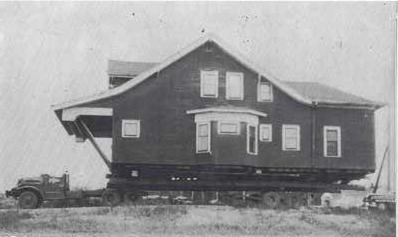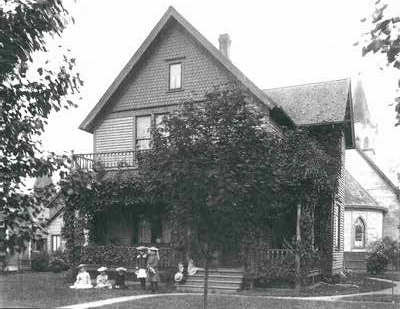Since Ely had been a mining town for nearly a hundred years means there were a number of mining locations. Usually at least one for each operating mine: Chandler, Pioneer, Sibley, Finn Hill, Spaulding, Calumet, Savoy, and 26 Location.
As mining operations expanded, even underground, the ground was deemed unstable and houses were moved to various places around town. They can be recognized as mostly two story homes, story and a half Cape Cod styles with two dormers, and other a more “salt box” style with a long sloping roof on the back of the house.
One of the well-known house movers was Harry Kidd. Another was Harold McGregor from Mountain Iron. It would be hard to know just how many houses they moved.
Houses were not the only things that moved. Bloomer’s was once Skala’s Bar and was moved diagonally across the block on Camp Street to Sheridan Street. The Jacob Pete (Luthens) house across the street from the Oasis’ church originally came from Section 30. It was sawed in half in order to accommodate the move. The “castle house” on West Conan Street originally stood where the Post Office is now. Ladybug Lodge on Shagawa was once the Finn Hall in Winton.
Houses were also moved to town from White Iron and the Winton Power Dam site. The Legacy Toys brick building was once the site of the Cormack General Store and the Chandler House Hotel. It was built of logs and came from Spaulding.
Several of the moves were noteworthy. Large buildings. Dee’s Apartments with two triplexes and two single family homes, all stood in Calumet Location. Calumet was across the road from the Grand Ely Lodge and down past the Pioneer Shaft and Dry House. The triplexes were loaded up individually and brought to Second Avenue and James Street.
One of the largest homes to be moved was that of Abijah James. After Mrs. James died, it stood empty for a number of years. That was at Sheridan Street and Fourth Avenue. The house was of 2-1/2 stories and had several fire places. The move was made to East Harvey Street and is now the home of Mike and Ernestine Forsman.
In 1923 or 1924, the original First Presbyterian Church at 226 Harvey Street was moved to the comer of James Street and 4th Avenue East. It was remodeled into apartments. The Presbyterians then built a substantial brick building which stands today after 100 years. The original church organ has surfaced recently and is “back” at the church. It is in very good condition.
If you would look to the right of the Ely Folk School, you will see a lot being used for various purposes. It has a shelter but the building originally there has been moved off. It was both the home and the office of Dr. P. D. Mc-Carty. In 1955 Eric Roescher of Fishermen’s Headquarters wanted to expand next door he acquired and sold the McCarty house to Tony and Betty Ann Jerich. They had the house moved to White Street. After Tony and Betty Ann’s mother died, Betty Ann sold the house to Len Katuaskas and moved into her relatives’ historic house next to the Presbyterian Church.
During the 1950s when Babbitt and Hoyt Lakes were each building town sites to accommodate the miners coming to work in the taconite mines, Modem Development Company manufactured prebuilt homes in Biwabik. A few came to Ely, one of which became the home of the Baptist church on Boundary Street.
Now there really now is no way to distinguish most of the buildings that have been moved. Behind the plaster or plasterboard walls one might find log ones which indicates the house came from elsewhere.
For more information contact Kelsey Cooke at the Ely-Winton Historical Society at 1900 East Camp Street on Tuesdays through Fridays, noon to 4 p.m., call 218-365-3226 or email ewhsmuseum@ gmail.com.



.jpg)









